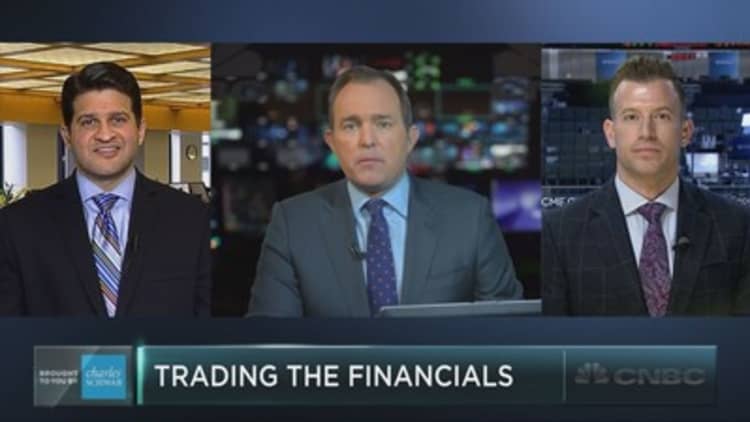
Who needs a Santa rally to boost year-end gains, when the momentum is already this strong?
Technicians are virtually crowing about the so-called seasonal setup for stocks this year. Seasonality describes predictable market behavior based on time of year. The rule of thumb is May to October is the weakest time, while November to April is the strongest. A Santa rally often occurs at the end of the year, and can be a positive streak of several percent.
But this year, technicians say the market trend was already strong, and it appears little can stop it now that the best time of year is here. According to analytics firm Kensho, in the past 20 years, the S&P 500 has risen an average gain of 1.4 percent in November 75 percent of the time, and gained another 1.4 percent in December, also 75 percent of the time.
That's the formula for a market melt-up, says Strategas technical analyst Todd Sohn. But in this case, he doesn't see the melt-up necessarily turning into a hard meltdown.
The final two months of the year are typically a good time for the stock market, especially when it has already recorded a double-digit gain for the year.
Technicians say the market could move higher in November and December anyway as it starts the strongest six months of the year, but Sohn says a strong 15 percent gain in the so far this year already gives it an added push.
This year's S&P 500 rally is not a rare event. It's happened 17 times since 1950, and in those years, the gains in November averaged 2.7 percent, and for the two final months of the year the S&P averaged another 4.9 percent, Sohn said.
"Really what it is, is strength against strength. If you use a baseball analogy. If you put up 10 runs through six or seven innings, you're probably putting up a lot more in the last couple," he said. "The seasonal backdrop is pointing to stronger-than-average returns, and you just have to be involved here for the next two months."
Ari Wald, technical strategist at Oppenheimer, agrees that the year-end should be particularly strong.
"Seasonals are supportive here and especially so when you're trending higher. Not only are November and December two of the best-performing months of the year, they're even stronger when you're starting the month above the 200-day moving average," Wald said. The S&P 500 closed out October at 2,575, while the 200-day is at 2,423.
"In general, we're just getting into the best six months of the year. ... For January specifically, is a month of the year when strength tends to beget strength," he said.
Wald said the stock market gains are not a hazardous "melt-up" but more of a steady healthy bull market that is marching higher, based on his indicators.
"Internal breadth is broad-based and we're seeing no signs of stress in credit indicators," he said.
Technicians are watching out for warning signs, like the 30-year high in the number of bulls versus bears in the Investors Intelligence weekly survey, a contrarian sign.
"There's some things we're mindful of heading into next year. On the sentiment side, the survey data is very aggressive," said Sohn.
Bulls reached 63.5 percent against just 14.4 percent for bears. A spread above 30 points to elevated risk and a spread above 40 calls for "defensive" measures. The spread now is the highest since the early part of 1987, months before the Black Monday stock market crash.
"It doesn't make the market vulnerable yet. It's more that in three to six months, how does participation look. Is the rally going to narrow?" Sohn said. "I think we still have more time before you sound the alarm on that."
Wald said the S&P gained 30 percent in 1987 after the bull-bear spread reached current levels.
Another warning sign is the flattening yield curve, with the spread between yields and 10-year note yields at a pre-financial crisis high of about 75 basis points. A flattening yield indicates the potential for an inversion in yield, where the longer-duration 10-year yield would fall below the two-year yield. That is a recession signal.
But technicians don't see that as a near-term event. The two-year is rising in anticipation of Fed rate hikes and a stronger economy. While the 10-year yield is not dropping because of economic worry.
"The fact it's being driven by a higher two-year yield rather than a declining 10-year makes it a little different than other cycles," said Sohn. "It's more of a shoulder shrug."
Wald said the concern about a flatter curve is unnecessary. "Investors always and constantly worry about a flatter yield curve, but historically the market continues to rally in these environments against a flatter curve," he said. "Historically it's been the inverted curve that's been the indicator ... it could be that a flatter curve could continue for the next three years."
Source: Strategas Research
Global macro strategist Vincent Deluard at INTL FCStone, argues in a recent note that a melt-up has already been underway and says they occur when optimistic sentiment gets more extreme. He studied 76 prior melt-ups in the Dow Jones industrial average and says they do not necessarily portend future losses.
In terms of the broader market, of the most recent 67 melt-ups, the S&P 500 averaged a 6.8 percent gain in the year following them, he said. That is less than the index's average gain of 8.1 percent "but a far cry from a meltdown."
Disclaimer: NBCUniversal, parent of CNBC, has a minority stake in Kensho.
WATCH: Financials may be set to surge



